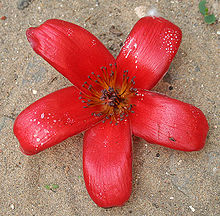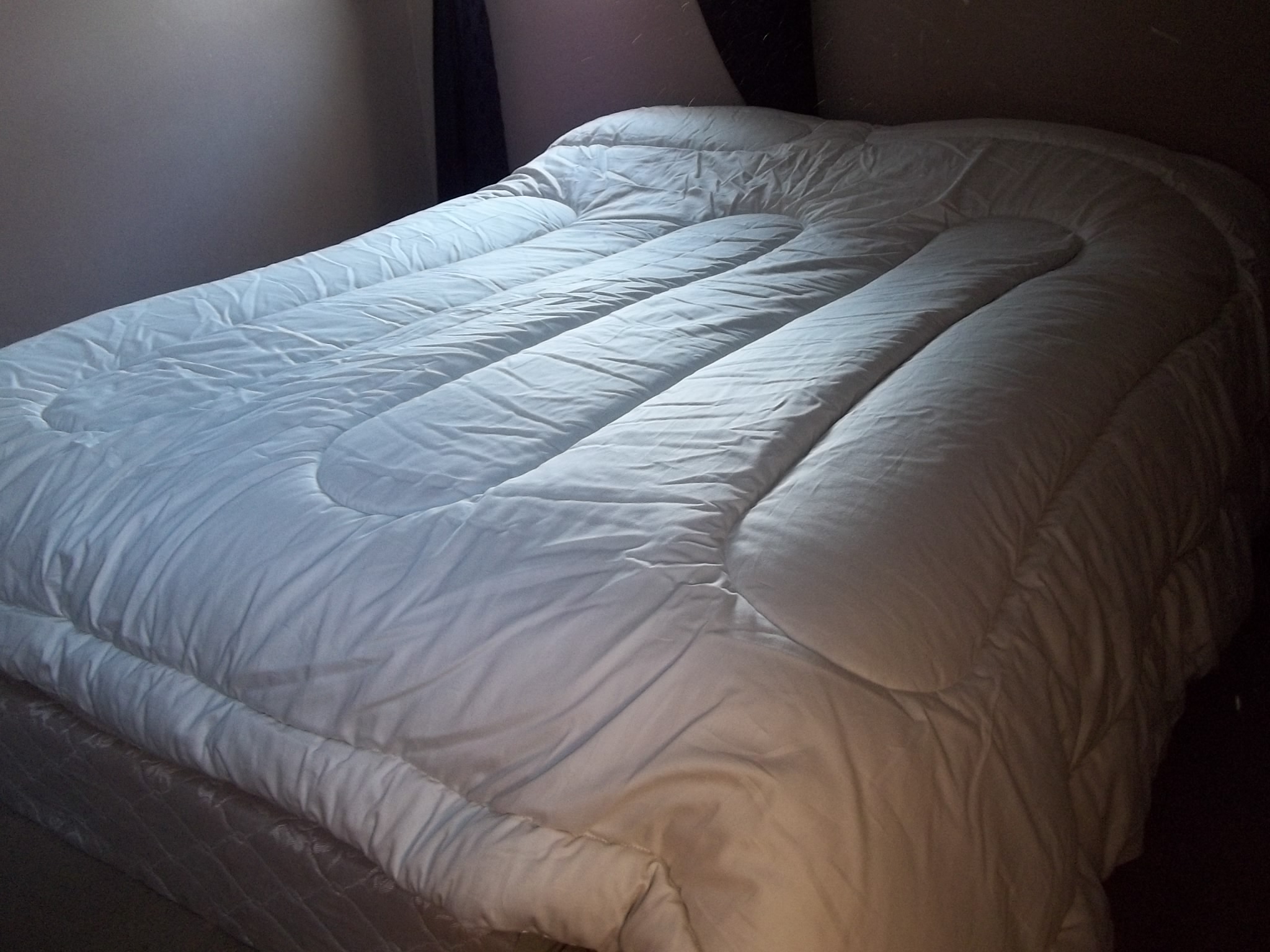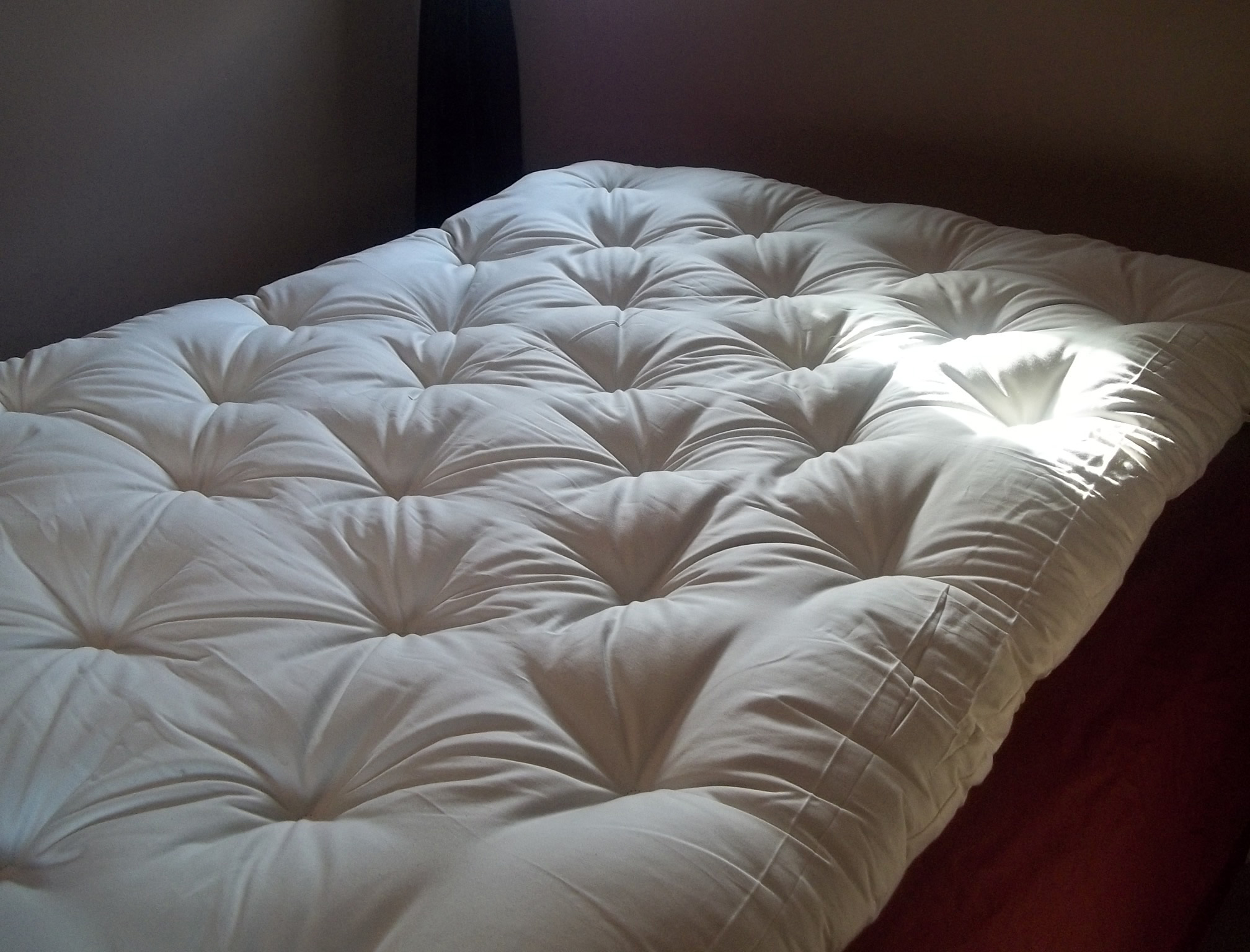
How to Cut Natural Latex
Posted on — Leave a comment
Perhaps you happened upon a piece of latex in our Clearance section that is just about the right size for your projects or maybe you have an old couch made of latex that you are ready to part with but you realize there is still life left in the foam, so you get creative. Your new project could use some natural latex but you want to save a few dollars by cutting it yourself and not paying us to cut it. Here is how you DIY a latex cut.
SUPPLIES:
- Electric Knife
- Two Tables the same Height
- Your Natural Latex Slab
TECHNIQUE:
The best tip I can give you is to use a slow, steady hand, not pulling the latex apart as you cut, but letting it sit still.
- Draw your cut on the latex with an extra fine tip permanent marker and a yardstick or an upside down tape measure. Make sure your line is straight as you will be watching it very closely when you are cutting. Do not draw your line according to the pinholes on the latex as they do not always line up vertically and horizontally to the edges of the latex. Rather measure from the actual edges of the latex.
- Place your two tables next to each order with a 5″ or so gap between them. Place the latex on the tables with the cut line in the space between the tables.
- An optional step, but perhaps beneficial step is lubricating your blades. If you have a silicone spray lubricant around, spray both sides of the blades to provide an easy cut.
- Position yourself in a comfortable position, accessible to the cut. Depending on how large your piece is, you may find it easiest to cut the latex if you crawl on top of it. If you do so, make sure your knees are not pulling on the area of latex around the cut.
- Position the cord of your knife so that it is not in your way as you move backward along the cut or in the cut’s way.
- Align your knife on the line, turn the blades on and very slowly, cut down your line. It is easiest to pull the knife toward you rather than to push it away from you. Keep your knife hand over the line so that you do not end up with a cut inches to the side of the line on the bottom of the piece. If you need to shift your position, turn the knife off first, adjust and resume. Do not stretch the latex when cutting. It is a very flexible foam and stretching or pulling it during your cutting will give you a wobbly cut line. The holes in the latex may give you a slightly wobbly drawn line; you may have to eyeball a straight line from each hole.
- Just like when you cut wood and leave behind sawdust, there will be a little shredded latex on the ground to sweep up.
Of course, if after reading this you have changed your mind about DIYing your cut, give us a call and we’ll cut it for you. To get a quote on a custom cut piece of latex, visit our Custom Cut Latex Calculator.
Happy DIYing.
Is Wool Alive?
Posted on — Leave a comment
When this herding dog saw a felted wool ball for the first time, he circled it, eying it, sniffing it, crawling up to it to nuzzle it and then backing away. He recognized the wool, but the wool did not move as a sheep does. After a while, he realized the wool was not alive, stopped herding it and had great fun with it. To be completely honest, the pictures are actually of his first exposure to a garden hose, but his owner said his initial reaction carried the same surprise and wariness.
The felt is so strong that not only did the dog not tear it up, when the wool was felted around an inflatable ball, his teeth did not puncture the ball, only the wool. His owner, Linda, said the ball is a special toy, to be taken out at certain times. While he did not tear it up at all in the short playtime with it, if given alone time with it, his teeth are strong enough to tear it to bits.
How do you get your dog to herd a ball without puncturing it? Wet felt it.
Linda and Kitty spent an afternoon with me experimenting with dog toys and wool, nylons and wet felting. They left with wool wrapped items to throw in the washing machine at home. You can see the prefelted items in the bottom right corner of the last picture.
- a croaker (long roll in stocking)
- a 12″ inflatable ball
- a 1″ squeaker
- wool balls
After wet felted, the croaker still croaked and the squeaker still squeaked. The 12″ ball did not fit in the leg of the nylon like the dryer balls do, but it did just barely fit into the waist of the stockings. You can see the funny creature with floppy nylon ears in the very bottom right of the picture.
Kitty and Linda are DIYers with Kitty traveling around the nation to dog shows selling leashes that Linda makes from braided leather.
Thanks to the New Hope and then the Golden Valley Farmers markets for introducing us.
Foraging for your Bedding: Corn Husks
Posted on — Leave a comment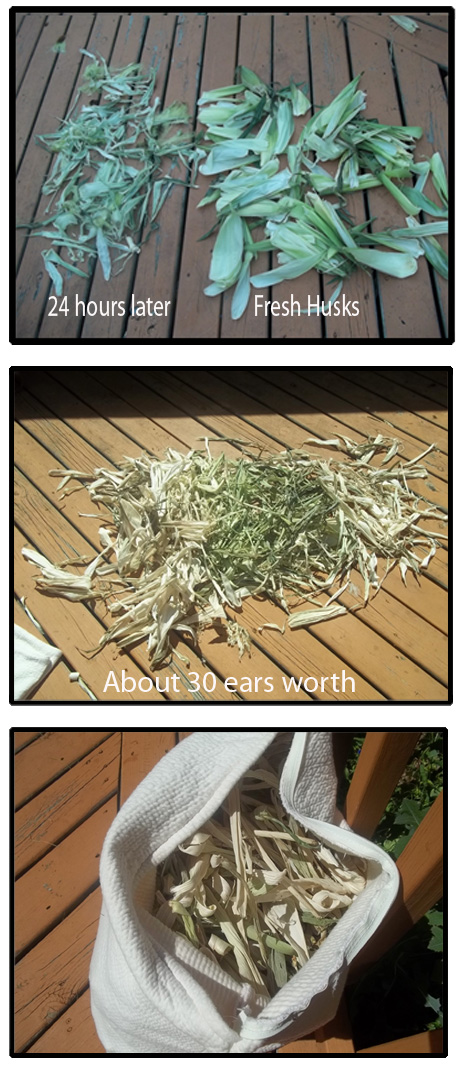 One of many things summer means is corn – fresh, hot, buttery corn. But as I was reading of basic mattress and pillow fills that our ancestors used to use, I realized there could be more to the corn plant than just its kernels. What about the husks? My guess is that tree leaves also would work for stuffing, but husks must be stronger than a standard tree leaf, so I collected cornhusks.
One of many things summer means is corn – fresh, hot, buttery corn. But as I was reading of basic mattress and pillow fills that our ancestors used to use, I realized there could be more to the corn plant than just its kernels. What about the husks? My guess is that tree leaves also would work for stuffing, but husks must be stronger than a standard tree leaf, so I collected cornhusks.
Some husks I dried in my basement and some on my deck. In the second picture, you can see the sun bleached the deck ones while the basement let the green color remain. I collected the husks from about 30 ears of corn. I spread each batch out to dry after the kids husked the corn for dinner. The leaves took about 25 hours to dry out on the deck.
Stuffing the pillow was simple. Sleeping on it was the real test. At first glance, it was rather lumpy, so I folded a towel in half and slept on two layers of towel on top of the pillow. The noise was the first apparent difficulty, but as I was quite tired from unpacking boxes all day, I fell asleep easily.
With the lumps not an issue and the noise not too bothersome, the next dilemma was the compression. Halfway through the first night, the pillow flattened out, loosing maybe 2″ from the beginning of the night. To be fair, I had only stuffed it loosely and dry husks crinkle up in distorted shapes to take out a bit more room than they would have if they were fresh. Since I did not want to make this a permanent pillow, instead of drying more husks and filling it up more, I put a thin pillow underneath it and slept on both the next night. Those few nights experience was enough. Then I went back to my wool pillow, which is soft and not noisy at all.
Pros:
- Ability to adjust fill amount to get desired height
- Fresh smell of hay
- Readily available, at least seasonally
Cons:
- Would have to be firm to get enough husks in the case to give the form any height
- Would make a nice home for bed bugs
Business Expanding & Moving
Posted on — Leave a commentBIG NEWS! 2 showrooms in 2 states
We’re moving. Local is becoming West Lafayette, IN. Due to my husband’s job change, West Lafayette, home of Purdue University will become this business’s home as well.. All online orders will be processed out of there as well as shipping of most custom orders and swaps of all Buy and Try. We will continue to show the latex and ticking samples out of our home there.
In NorthEast Minneapolis, a friend who also believes in naturally living will open up a room in her house for a showroom. In both MN and IN, you will be able to try out the different latex densities and feel the different ticking options, as well as test the pillows and wool products out. [EDIT July, 2015: We are now even closer to the highway in Lafayette, IN.] [EDIT: November 2015: The NE Minneapolis showroom is no in Eden Prairie, just south of Minneapolis.]
Contact information stays the same. Warranties, Buy and Try Policy and our products stay the same. To schedule showings in MN or IN, see our contact page.
Thanks to all of you in Minneapolis who have helped our business grow. We hope we can continue to offer you bedding options that meet your needs, enable your choices and work for your pocketbook. Those reasons are the some of the best reasons to DIY.
Stock Sale – 10% Off
Posted on — Leave a commentFriday, August 15 – Tuesday, August 19 – All items in stock are 10% off.
Midnight to midnight.
This list includes all of the following items:
- Almost all pillow parts, kits and fills – Use coupon code “stock10%” at checkout for 10% off.
- Shredded Natural Latex Pillow Kit
- Wool Pillow Kit
- Kapok Pillow Kit
- Kapok by the lb.
- Shredded Natural Latex by the lb.
- Outer Pillow Cases
- Inner Pillow Case
- Quilted Pillow Case, Standard & Travel
- All Clearance items- Use coupon code “stock10%” at checkout for 10% off.
- Latex
- King Firm
- Quilted Wool Ticking, Twin 6″
- Twill Ticking, 4″ Twin
- Twill Ticking, 6″ Crib
- Latex
- Natural Latex
- Twin Medium
- Twin Firm
- Full Extra Firm
- Full Hard
- 1/2 Queen Medium
- 1/2 Queen Firm
- California King Soft
- Wool
- 3″ Topper, King
- DIY Wool Puddle Pads
- Wool Balls
- Wool Felt Kit
- Quilted Wool Ticking, Twin 9″
As stock is sold, items will be removed from the sale, though will still be available for regular price purchase. Stock items will ship out on Thursday 8/21.
Why the stock sale? In short:
Summer Vacation 8/22
Our shop will be closed for shipping from 8/22 – 9/1. Some orders will be processed, but they may be delayed about a week. Orders may still be placed online and emails may be sent, but phone calls may not be answered until 9/1. Thank you for giving our family a nonworking week!
Does your foam have fire retardants in it?
Posted on — Leave a commentDuke University is inviting you to submit a marble size sample of your couch or mattress foam. They will test 50 samples a month to see if they contain fire retardants.
To participate in their study, click here. Click around the top menu bar to see the study more. To see their findings so far, click here.
Foraging your Own Bedding – Shimul or Bombax Silk
Posted on — Leave a commentAnother foraging opportunity… if you live in China or India or Cuba or really, the Tropics. This tree has silk fibers much like the kapok tree and is commonly used to make mattresses in Asia.
This plant has a very long bloom period. It opens first bloom in fall, lights up the sky throughout winter and may still have a bloom or two in spring.
Like the kapok tree, it is a dry deciduous tree that loses its leaves in the dry season and replaces them with huge, bulky red flowers near top of tree with wide petals. The flowers up to 6″ across are edible.
For interest’s sake, the red-silk cotton tree, Bombax ceiba, is sometimes mistakenly called “Kapok” because it produces floss. The true Kapok is Ceiba pentandra and is not common in Florida. The red-silk cotton is in the Malvaceae family, but is sometimes placed in the Bombacaceae family by some authors.
Just like wool mattresses, sleepers recard their silk every few years as it compacts very firmly. Natural bug-repellents are used mixed in the cotton like eucalyptus or strong versions of mint or lavender.
Firefighter Cancer Study on Flame Retardants
Posted on — Leave a commentA study that came out last year, linked cancer to flame retardants in firefighters. It was a thorough and one of kind study. To quote,
“Our study provides clear evidence that firefighters are exposed to high levels of cancer-causing chemicals including brominated flame retardants and their combustion by-products – dioxins and furans – that are formed during fires by the burning of flame-retarded foam furniture, televisions, computers and building materials. Firefighters have much higher levels and different patterns of these chemicals in their blood than the general population. There is no doubt that firefighting is a dangerous occupation. What we have shown here points to the possible link between firefighting and cancer.”
During fires, large amounts of cancer-causing dioxins and furans are produced by combustion of materials containing brominated and chlorinated substrate. Since firefighters are known to have high rates of cancer, the study focuses on the exposure of firefighters to these compounds while firefighting.
Previous studies of firefighters have focused on exposure to chlorinated dioxins and furans. This pilot study is the first to measure brominated dioxins/furans (PBDD/Fs) in blood of firefighters. Because homes and offices contain large amounts of brominated flame retardants, we expected to find brominated dioxins/furans in firefighter blood.
*Brominated dioxin and furan concentrations in firefighter blood were extremely high, and were 21 times more toxic than the chlorinated dioxins and furans. The authors conclude that brominated dioxins and furans may pose a greater cancer risk to firefighters than previously thought.
*Patterns of the brominated flame retardants, PBDEs in the firefighters were dominated by deca-BDE. A deca-dominated pattern is not found in the general population, but is typical of the pattern found in blood of e waste recyclers continuously exposed to deca-BDE resulting from open burning of plastic TVs and computers.
*The firefighters also had elevated levels of two perfluorinated chemicals, PFOA and PFNA. PFOA, a cancer-causing chemical that is linked to the risk of stroke, was phased out of commerce in 2001 but is released in large amounts from household and building materials during fires.
*The findings of this pilot study indicate that firefighters are at risk for cancer and serious health effects from their occupational exposure. A larger study of firefighters is planned.
Read more about the study at the Marine Environmental Research Institute.
Hear the lead scientist talk about the findings in the video:
Farmers Markets – New Hope and Golden Valley
Posted on — Leave a commentIf you stop by the New Hope Farmers Market any Saturday (8-1) or the Golden Valley Farmers Market Sundays (8-12) this summer, make sure to stop by and say hi.
We’ll be selling our Pillow Kits and Dryer Balls and wool craft kits and hanging out all morning, every weekend.
Why we’re at a farmers market when we’re not farmers, I’m not really sure. But personally I support local farmers and appreciate those sorts of people and apparently we’re “crafters” since we DIY our products as much as possible.
New Hope is at Rockford Rd. and Xylon (the old Kmart parking lot)
Golden Valley is at 7800 Golden Valley Rd (under the watertower)
See you there.
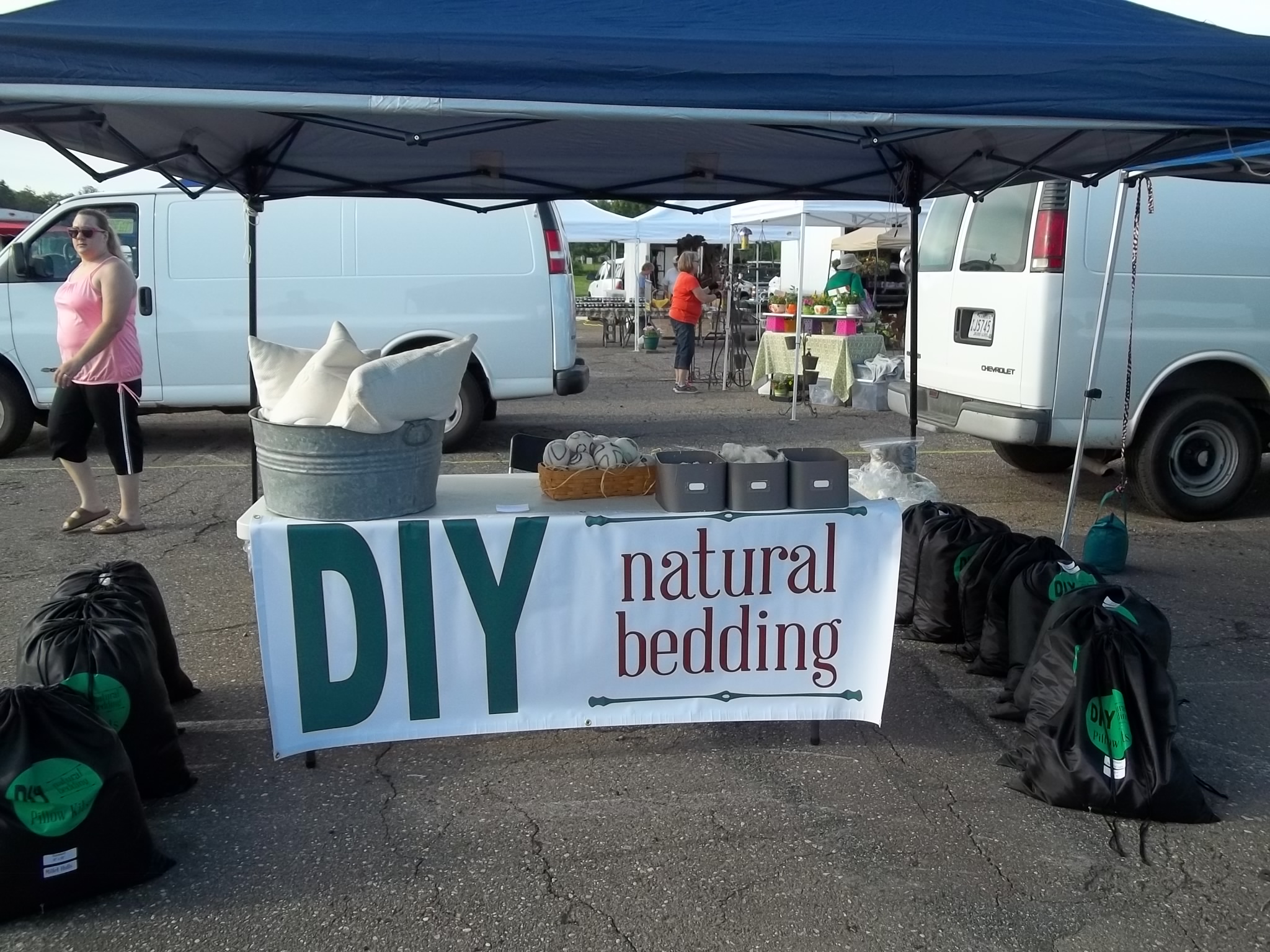
DIY Pillow Making Event
Posted on — Leave a comment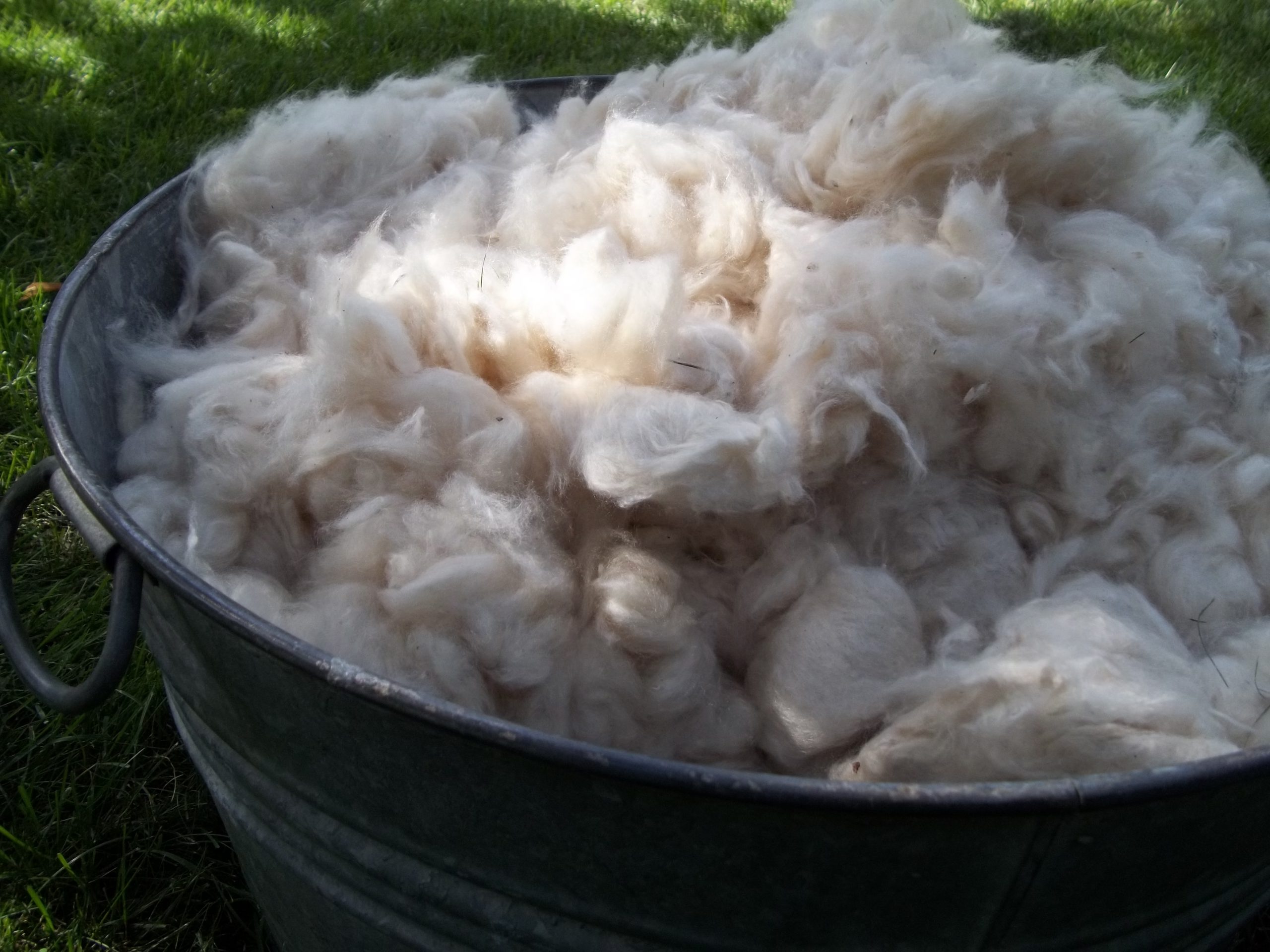
 Join us to shred some natural latex or fluff some kapok to fill your pillow. We will provide the pillow cases, the unfluffed kapok and the latex falloff. You choose your pillow sizes and which fill you would like. Also, bring a favorite practice of yours to share, some trick or solution that you use to follow a natural path.
Join us to shred some natural latex or fluff some kapok to fill your pillow. We will provide the pillow cases, the unfluffed kapok and the latex falloff. You choose your pillow sizes and which fill you would like. Also, bring a favorite practice of yours to share, some trick or solution that you use to follow a natural path.
This event is open to all, so feel free to invite anyone who might enjoy physically investing in their pillows. We really will be using our hands to pull apart bits of natural latex or separating the kapok clumps to create lofty, smooth pillows.
Please RSVP with your pillow preference by May 23 here or by email dbrenton@diynaturalbedding.com or phone 763-445-9676.
![]()
Cost is just for supplies. Since you will be shredding your own latex and fluffing your own kapok, costs are less than the pillow kits online.
Foraging for your Bedding: Cattails
Posted on — Leave a commentA couple weeks ago, when the wind was sharp, the temperature was single digits and the ice was frozen, a daughter and I made a trip to a nearby lake. It is a double lake, bottlenecked in the middle with a bridge spanning that narrow opening and between the two sides of the lake, a path lined by tall cattails. We brought along a bag and made sure to wear our boots and mittens. Instead of traversing the lake, we hopped into the forest of cattails and started snapping. Snapping off the top spikes and snapping the stems beneath the fluff. A crust of icy snow kept us on top of the uneven mounds most of the time with only a few breakthroughs to snow up to our knees. The wind was calmed among the stems, almost as tall as I was.
A gentlemen walking past stopped and inquired after what we were doing. As we had already chatted with him on his first walk about the weather’s reluctance to give up winter, I considered his inquiry a friendly neighborly touch, quite in contrast to the very nervous park ranger who stopped me foraging last summer. Before we could answer, he told us we should be picking the cattails in the fall before the fluff starts to loosen. Then, he said, we could dye the cattails decorative colors and use them in table settings. I thanked him for his tip as he walked back the path again and we went back to our snapping.
With the stems poking through the bag, catching on my jeans and our bag starting to look rather full, we trotted back to the van, crunching white ice frozen in the street curbs on our way.
In the warmth of our home over a rug, I set up. One clean garbage bag for the pillowcase, one paper bag for the stems and one bag of cattails. Peeling the fluff down with my thumb, I could scrape a path in the seeds so I could bend the rest of the fluff off bit by bit. Last summer when taking pictures for the website, I stuck a stack of pillows under our grape vines and stained a pillowcase, but that left a perfect pillowcase for my purpose, especially as it was a nice, thick double knit one. Over an hour or two, I scraped and peeled the seeds into the case. Occasionally I stirred the fluff loose from itself so it would not stay clumped. You can imagine the beauty of the air around me when my almost 3 year started to help. Every wave of his cattail loosened little floating seeds that were as close as you can come to falling snow inside the house. Though the long winter’s afternoon when I let the kids shred packing Styrofoam in the living room to create a snow carnival was, hands down, a messier affair.
I slept on the pillow last night and the night before. I slept soundly and quite happily. For an adjustable fill pillow, the fill does not roll around when shaken like the shredded latex pillow, nor did I over stuff the pillow so that it would keep its shape like a couch pillow should. The cattails made the pillow flatish and softish, not firm, perhaps a little lumpy, though fill could easily be shifted to a new spot.
So if you want to forage your own cattails, get your waders on and go get them before the wind does. New stalks will be growing in May or June. I could share my spot with you as even our 100 cattails barely made a dent in the thousands that bordered this lake. If you ever want to plant some, take some seeds from your pillow as the seeds are viable for 100 years or so. And if you really want to get into cattails, look up when to eat them and their pollen.
Thanks to Tyler, a customer who bought a pillow case just for this purpose, for this idea.
Happy foraging.
Free Shipping Changing
Posted on — Leave a commentWhile we really like to offer good deals to you and we keep our prices low so that we can make your purchases more affordable, we have realized we cannot offer free shipping on all purchases anymore.
In a few weeks, flat rate shipping will be added to every item. We will still share a bit of the shipping with you, but will have to ask that you share some of it with us too.
So if you want that free shipping while it lasts, take advantage of it.
Eliminate Fibromyalgia Pain with Wool
Posted on — Leave a commentHow would you like to see decreases in pain by 84% without having to change your diet or exercise habits?
A recent study conducted showed that sleeping on wool (as well as wearing it and being in contact with it all the time) can drastically improve your feeling of health.
Apparently, those hollow, spiral fibers made of a keratin so much like our own body produces can reduce muscle stiffness and provide a better night’s sleep than ever before. For more information on the study: summary of the study.
Futons, Couch Cushions and Latex
Posted on — 1 CommentNatural latex foam can be cut to almost any size. This ability to be resized, along with its flexibility and its comfort, makes it a high-end fill to any piece of furniture.
![]()
SIZE
Our Arpico natural latex comes in 6” slabs and as large as 76” x 80.” Since it is Dunlop processed, the molds are as large as an Eastern King. Talalay processed mold are only as large as a Queen. A 6” slab gives you enough depth for a couch cushion or the ability to trim it down an inch or two.
To obtain a quote on a custom size, visit our Custom Cut Latex Calculator.
DEPTH and FIRMNESS
The depth of the piece will affect your preference of firmness. A 3” extra firm or hard piece would be as thin as you would want. Four inches or five inches would be more comfortable and allow more people types to sit on it. Six inches is definitely a safe choice. A person of any weight could sit on it and not feel the slats or springs underneath it. When you get into the six inch depth, you can decrease the density of the foam to a firm if you like. A back cushion for a couch commonly is cut out of a Soft piece of latex as there is no gravity holding the sitter to it, only body weight.
Why is thicker better? When a person’s weight is pinpointed directly into one spot of the latex, the pressure points are much larger than when a sleeper stretches out and spreads his pressure points out.
WOOL
In short, I would consider a wool wrap around your latex if using it for upholstery purposes. It is not necessary, but it has a few purposes. Besides acting as a physical barrier between the latex and the elements that cause latex to deteriorate, it also can act a little bit of the softening that a down blanket would. Consider it a way to ease into the comfortable support of latex and to reduce the bounce. It always serves to buffer the air space between the latex and the case.
FRAMES
We do not make frames, but I have multiple customer who specialize in custom furniture, woodwork, titanium welding and metalwork. Contact me for their contact information.
SEWING
Send us your fabric and we can sew it up for you or we can use our fabric to sew you cases. Woven fabrics vs. knits are strong and durable for upholstery use.
If you are looking for organic fabrics, there are more sources than ever before. Check out Two Sisters Eco Textiles or Organic Cotton Plus and note their color grown cotton fabrics as well as the hemp and wool fabrics. They also have subtle patterns appropriate for upholstery uses. GOTS organic is the best standard available but the standard has only been around a few years so it is a taking a while for many manufacturers to catch up. Organic fabric (USDA) is common, even fabric.com carries it.
Cording is a decorative accent that can be added to the edges of a cushion. We can add it for you if you like. However, if your latex will be folded for display as a futon, I do not recommend cording as it will not necessarily perch properly on the edge of the latex. No need to highlight an askew seam. Another decorative accent is gussets; gussets are side panels sewing on sewn on the sides of the cushion. Pictures available on our Custom Sewing Page.
GENERAL STRUCTURE
According to the web, cheap sofas use foam alone. Better sofas use foam core within a down & feather blanket (wrap). The ratio of down to feathers is usually only a 10/90 ratio, but the greater the ration of down to feathers, the better. Even better sofas use a spring core encased in foam. The best of the better sofas use either a spring core that is encased in foam that is then encased in a down wrap or an all-down and feather cushion.
The very best couches a use latex core with springs. In order to get this combination you would have to visit an upscale upholsterer. (Yes, customers do take our latex to such shops.) This style is rarely composed in the United States but apparently, the French do so. Good upholstery, depending upon the style, has lots of springs. There can be springs in the seat, the back, and in the arms. That’s what makes a great upholstery job look “full” and it keeps the sofa looking that way for years but it’s very expensive and usually seen only on hand made sofas. Often on these handmade sofas, you will see hand stitching as well. This upholstery company has some reupholstered pictures of before and after of some high quality piece of furniture.
For more reading on upholstering tips, here is a summary article.
Visit our Custom Cut Latex Calculator to get a quote on a custom cut piece of natural latex. If you want to cut your own latex, electric knives work well.
Expandable Ticking Pattern Here
Posted on — Leave a commentA long awaited pattern is ready for delivery. Our most unique ticking and complicated pattern too. You will not find a product anywhere on the net like this because it did not exist until we created it. And we’re offering you the option to create it too.
It is available in two formats:
PATTERN
PATTERN KIT
The pattern is quite simply the 12-page pattern with pictures, instructions, and a detailed cutting chart. The pattern kit is the pattern with the proper length of zipper, 2 zipper pulls and the appropriate length of fabric to preshrink.
One pattern for all your bed sizes. If you need multiple sizes, you need only one pattern purchase.
Our pattern is licensed under a creative commons license. In short, this license acknowledges that ideas are free and knowledge can be shared willingly. It means you may remix, tweak, and build upon our work even for commercial purposes, as long as you credit us AND license your new creations under the identical terms (Creative Commons Attribution-ShareAlike 3.0 Unported License).
Happy DIYing.
Quilted Fabric by the yard now available
Posted on — Leave a commentQuilted Fabric now available!
Pillowcase, ticking, quilt for your bed, you name it.
Here is life simplified. You could spend an hour picking out fabric, cut it to size, purchase some wool batting, drive to a long arm quilter, wait a few weeks to get it quilted together and then hand sew the binding on like a normal quilter, or… you could do it the easy way. We’ll quilt it, you sew it as you like.
We also have added zipper by the foot to our supplies page as retail fabric stores will not have zipper lengths suitable for mattress sizes.
Fire, Legalities, and Wool
Posted on — Leave a commentA new post in the Of Interest section might interest you: Fire, Legalities and Wool.
- How did the laws on flames comes to be?
- What are the laws?
- Why we do not need to use flame retardants?
- Can wool pass the burn test?
- Could our products pass the burn test?
![]()
For more information on fire retardants and your health, look for another article in the near future.
Wool Comforters – another DIY project in the works
Posted on — Leave a commentComforters! Available in two different weights with our local farm wool and GOTS organic sateen fabric. Made locally at St. Peter Woolen mill. Sometime this year we will also post a DIY pattern on making your own with a few variations to account for skills and tools on hand.
These are not on our website yet, so if you would like to see a sample or order one made, stop on by or give a call. Each piece is custom made per order.
UPDATE: They are on our website! See their product here.
Wool Toppers – a secret offering
Posted on — Leave a commentFarm wool and GOTS organic percale fabric, made locally at St. Peter’s Woolen Mill. Maybe you’d like one. Contact us if so. It’s not on our website yet. We’ll post it later when we get our DIY pattern available for it, but in the meantime, we can make them for you. Comes with elastic straps on each corner.
Giveaway
Posted on — Leave a commentThe winnings
Pick from your choice of pillows – Shredded Natural Latex or Kapok Fiber. All our pillows are adjustable fill, meaning the liner has a zipper enabling you to take out extra fill or add in extra fill, to create just the right height of pillow for your night. The pillows offered are standard size; if you want a larger size, you can pay the difference.
The how
With a new website that comes with a name change and an inability to magically change this facebook address, we need to abandon ship and start anew.
There are three ways to win:
- Like our new facebook page.
- Add us in your circles in Google+ .
- For those of you without social networking hook ups, place a comment or a review somewhere on our website here.
You will eventually see cross postings from the blog to Google+ and Facebook. If you enter in more than one way, we will count your entry only once.
Thanks for spreading the word.
Happy winnings,
Deborah
Welcome
Posted on — Leave a commentWelcome to DIY Natural Bedding.
We hope you, like us, enjoy doing things yourself and like living naturally. We are here to enable you to have the bedding you like with industry quality products, yet at diy prices. We like to ask questions and hope you feel comfortable doing the same. We are people first, a business second. We work out of our home to enable that balance as well as to keep costs down for you. Stop by for a visit (well, call first please), we’d love to meet you and chat.
If you’re the facebook type, we’re there. If you’re on Google +, put us in your circles. And then we’re here too. See you around.
Deborah and Bob Brenton

